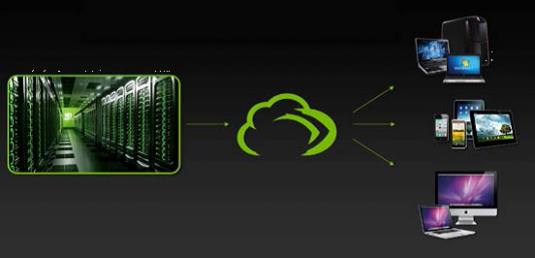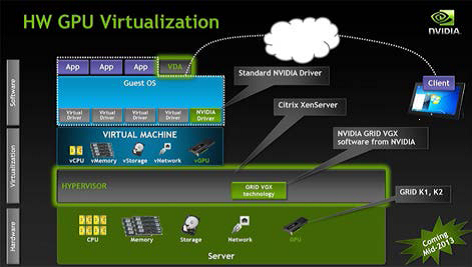The “Blade Workstation” given a broader role to play in remote graphics
By Alex Herrera
HP recently announced it was supporting Nvidia’s GRID technology in its next-generation graphics server blade, the HP WS460c. And while we’ve long expected to see a GRID-enabled server product from HP, the form this support takes is noteworthy, one that should benefit from the far broader opportunities that GRID’s advancements in remote rendering technology should provide.

With GRID, Nvidia is proposing moving “GPUs to the Cloud,” promising high-quality, high-performance 3D graphics anywhere, any time, on any device. The technology promises “remote graphics with local look and feel,” an interactive visual experience independent of whether rendering is being performed by the server in the local datacenter or by some cloud service halfway around the world.
Now, HP’s announcement of GRID support was no surprise. For over a year, as Nvidia has been previewing and drumming up support for GRID, it has consistently touted HP as a partner. Clearly a server-class GRID product was in the offering. But what is interesting is how HP is planning this (at least one phase of) GRID deployment: by upgrading the existing ws460c Graphics Server Blade, or what the company previously called Blade Workstations. The new GRID-enabled version of the WS460c will be available this fall at prices starting at just under $9,000.
The current model WS460c Blade Workstation is a conventional blade server built on Intel Core i5 or Pentium CPUs, with the exception that added to each blade’s processors and memory is a small, low -profile, low-power Nvidia Quadro MXM module. Rather than rendering graphics on the client side— with a deskside workstation, for example example—the Blade Workstation model puts the rendering burden back on the server, which uses the network to send images to a relatively “dumb” client.
With the existing solutions, one graphics-enabled blade server (a.k.a. Blade Workstation) is allocated to one user via a mode commonly referred to as “GPU pass-through.” That is, each user still gets a dedicated GPU, but rather than sitting deskside in the client, that GPU is in one of many blades residing in a remote server. All that’s required of the client—a thin one perhaps—is handling I/O (display, USB, keyboard).
To date, graphics-enabled blade servers have been interesting, but with appeal generally limited to niche applications. We estimate the company’s been selling approximately 10,000 to 20,000 blade workstations a year, primarily to spaces that don’t have the greatest demand for performance and also value quiet, cooler, and less obtrusive computing at the desk. Think financial markets.
GRID and VGX should sweeten the proposition for prospective buyers
Upgrading the WS460c’s support from conventional Quadro modules to Nvidia’s new GRID K1 and K2 GPUs is not only logical, it will expand the appeal and business prospects of HP Graphics Server Blades. Sure, GPU pass-through can be useful in some application spaces that value the fact that the bulk of the processing and data is tucked away in the backroom rather than deskside.
Still, this mode’s limitation that one GPU can only connect to one client/user at a time is a significant drawback for most workstation-type applications. And Nvidia didn’t put this much wood behind the GRID arrow to stop with this simple version of server-based graphics—not when there’s a lot more value to exploit in having remote GPU power shared among multiple clients in multiple locations. The payoff is in virtualizing the GPU, such that one physical, server-based GPU can render graphics for more than one remote client; perhaps many.

With GRID’s VGX mode, a physical GPU with virtualization support (along with compatible VGX support in the hypervisor) presents a true virtual GPU (i.e., “vGPU”) to the application, similar to the rest of the virtual machine components (e.g., vCPU, vMemory). And because support is mostly in hardware, there are minimal performance-wasting—and latency increasing—cycles spent in software abstraction and maintaining API and application compatibility.
Benefits of centralizing data are many, particularly as the sheer volume of visual computing data continues to explode. When models and supporting data were relatively small, compared to image pixels, it might have been easier to move the model back and forth from client to server or among clients. But we’ve gotten to a point where the opposite is true. Depending on the application space, visualization data has moved into the Terabytes, with growth extrapolation going only one way … up, and steeply. Meanwhile, frame rates are static (e.g., 60 Hz), and growth in pixels, while up, is on a shallower curve, not to mention, for many, in the area of diminishing returns.
As a result, it makes sense to question the old paradigm of moving the models and data to the client to keep all the pixel bandwidth local, and instead consider a new one: leave that big data in a central datacenter, visualize it on a remote server, and ship the pixels to a thin, and arguably less expensive, client. Once that shift is made, several significant advantages emerge, benefiting various types of users engaged in a range of visually rich tasks. A user can more easily share that data with a colleague, whether sitting in an adjoining cubicle or in an office a half a world away. And IT managers can more readily add and manage users, security, and applications with data and computes located in one physical location.
In conjunction with the WS460c, HP unveiled a companion thin client solution, the HP t820. The t820 runs Windows Embedded Standard OS on a hardware foundation of Intel Core i5 processor, with storage, memory, communications, and I/O resembling a PC or low-end workstation. With the t820, GRID technology, and supporting VDI applications, HP can offer a complete solution for enterprises looking to either replace or augment deskside workstations with server-side computation and rendering.

Our take
We think remote-rendering technology, particularly with the capabilities and performance GRID promises with virtualized GPU sharing, will have a role to play with customers and installations that today rely on conventional workstations. How big a role is yet to be seen, depending on many questions we continue to raise, most notably how well end-to-end latency can be minimized and controlled to truly deliver that “local look and feel.”
With the WS460c, HP won’t be standing on the sidelines watching how the GRID/VGX technology deployment changes the shape of the workstation computing landscape. It can’t afford to watch and wait; as the leader in workstation volume, it needs to be ready to not only provide cutting-edge workstations, but to provide any technology that may be in a position to replace workstations. HP didn’t get to be the world leader in workstations by leaving things to chance. GRID-enabled blade servers are helping cover the company’s bases, regardless of how the acceptance of yet-to-be-proven remote rendering evolves.
Alex Herrera is a senior contributing analyst at Jon Peddie Research.





